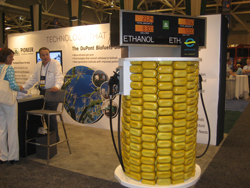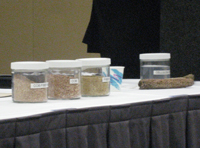 VeraSun Energy Corporation, in partnership with General Motors, today announced the opening of the first E85 retail fueling location in Washington, D.C.
VeraSun Energy Corporation, in partnership with General Motors, today announced the opening of the first E85 retail fueling location in Washington, D.C.
According to a company release, the VeraSun branded VE85™ is now available at the Georgetown Chevron and at the Navy Exchange station near the Pentagon.
“This partnership exemplifies the efforts being made to improve the availability of E85 in our nation.” said Don Endres, VeraSun’s Chairman and CEO.
Enterprise Rent-A-Car joined VeraSun and GM on this initiative by announcing that it is designating its premier rental location in Washington, D.C., as an official “E85/FlexFuel branch.” Owning the world’s largest fleet of FlexFuel Vehicles, with more than 41,000 cars and trucks, Enterprise is committing to fueling 50 GM FlexFuel vehicles from its location at 1029 Vermont Ave. N.W., at the Georgetown Chevron. The vehicles will also be stocked with materials about VE85™ and directions to the fueling location.


 Porsche will introduce an ethanol-mixed fuel in its Le Mans Prototype 2 RS Spyders for the July 7
Porsche will introduce an ethanol-mixed fuel in its Le Mans Prototype 2 RS Spyders for the July 7  According to an
According to an  The American Le Mans Series highlighted its transition to alternative fuels with a display Thursday of sports cars and racing machines on the edge of Central Park.
The American Le Mans Series highlighted its transition to alternative fuels with a display Thursday of sports cars and racing machines on the edge of Central Park. For a long time, Texas was known to be a leader in the non-renewable energy fields… in particular, the petroleum market. But it looks like the Lone Star State is now poised to dominate the green fuel picture as well.
For a long time, Texas was known to be a leader in the non-renewable energy fields… in particular, the petroleum market. But it looks like the Lone Star State is now poised to dominate the green fuel picture as well. One of the award winners, Macon Municipal Utilities reduced their energy use by 25 percent. Macon Municipal Utilities installed a 10 megawatt (MW) natural gas-fired combustion turbine CHP system at its 45 million gallon-per-year ethanol plant in Northeast Missouri. The CHP system will likely reduce greenhouse gas emissions by an estimated 28,000 tons per year, which is equivalent to the annual emissions of more than 4,500 cars.
One of the award winners, Macon Municipal Utilities reduced their energy use by 25 percent. Macon Municipal Utilities installed a 10 megawatt (MW) natural gas-fired combustion turbine CHP system at its 45 million gallon-per-year ethanol plant in Northeast Missouri. The CHP system will likely reduce greenhouse gas emissions by an estimated 28,000 tons per year, which is equivalent to the annual emissions of more than 4,500 cars. At its 40 million gallon-per-year ethanol plant in Illinois, Adkins Energy LLC, decreased their energy use by 15 percent with a 5 MW natural gas-fired combustion turbine CHP system. The CHP system reduces greenhouse gas emissions by an estimated 8,700 tons per year, which is equivalent to the annual emissions of 1,400 cars.
At its 40 million gallon-per-year ethanol plant in Illinois, Adkins Energy LLC, decreased their energy use by 15 percent with a 5 MW natural gas-fired combustion turbine CHP system. The CHP system reduces greenhouse gas emissions by an estimated 8,700 tons per year, which is equivalent to the annual emissions of 1,400 cars. Thanks to the
Thanks to the  In an effort to be more friendly to the planet, Prince Charles says he is using biodiesel in a couple of his personal vehicles… and might even use the green fuel on the Royal Train.
In an effort to be more friendly to the planet, Prince Charles says he is using biodiesel in a couple of his personal vehicles… and might even use the green fuel on the Royal Train. “We identified the metabolic processes and conditions that allow a known strain of E. coli to convert glycerin into ethanol,” said chemical engineer Ramon Gonzalez. “It’s also very efficient. We estimate the operational costs to be about 40 percent less that those of producing ethanol from corn.”
“We identified the metabolic processes and conditions that allow a known strain of E. coli to convert glycerin into ethanol,” said chemical engineer Ramon Gonzalez. “It’s also very efficient. We estimate the operational costs to be about 40 percent less that those of producing ethanol from corn.” Consolidated Biofuels and International Bio Fuels Corp. have announced plans to jointly open a biodiesel plant in Arkansas… one that will be among the biggest in the country.
Consolidated Biofuels and International Bio Fuels Corp. have announced plans to jointly open a biodiesel plant in Arkansas… one that will be among the biggest in the country. The refinery will be built on a 65 acre lot on the Mississippi Port of Yellow Bend and will produce 150 million gallons of biodiesel and 70 million bushels of soybean oil crush annually.
The refinery will be built on a 65 acre lot on the Mississippi Port of Yellow Bend and will produce 150 million gallons of biodiesel and 70 million bushels of soybean oil crush annually. 
 “This technology is a significant milestone in helping increase ethanol output per acre,” said Russ Sanders, Pioneer Director of Marketing. “In FOSS instruments, the Pioneer Ethanol Yield Potential Calibration provides nearly instant prediction of ethanol yield potential in corn grain and provides an estimated yield in gallons per bushel terms.”
“This technology is a significant milestone in helping increase ethanol output per acre,” said Russ Sanders, Pioneer Director of Marketing. “In FOSS instruments, the Pioneer Ethanol Yield Potential Calibration provides nearly instant prediction of ethanol yield potential in corn grain and provides an estimated yield in gallons per bushel terms.” At the 2007 Fuel Ethanol Workshop in St. Louis on Wednesday, the nation’s largest dry-mill ethanol producer announced the successful production of cellulosic ethanol from corn cobs.
At the 2007 Fuel Ethanol Workshop in St. Louis on Wednesday, the nation’s largest dry-mill ethanol producer announced the successful production of cellulosic ethanol from corn cobs.  At a press conference,
At a press conference,  Dr. Mark Stowers, VP of Research & Development for POET, says they expect the use of corn cobs for ethanol production to result in an 11 percent increase in the amount of ethanol per bushel of corn. “And when you look at it on an acreage basis, that’s about 27 percent more ethanol per acre.”
Dr. Mark Stowers, VP of Research & Development for POET, says they expect the use of corn cobs for ethanol production to result in an 11 percent increase in the amount of ethanol per bushel of corn. “And when you look at it on an acreage basis, that’s about 27 percent more ethanol per acre.”